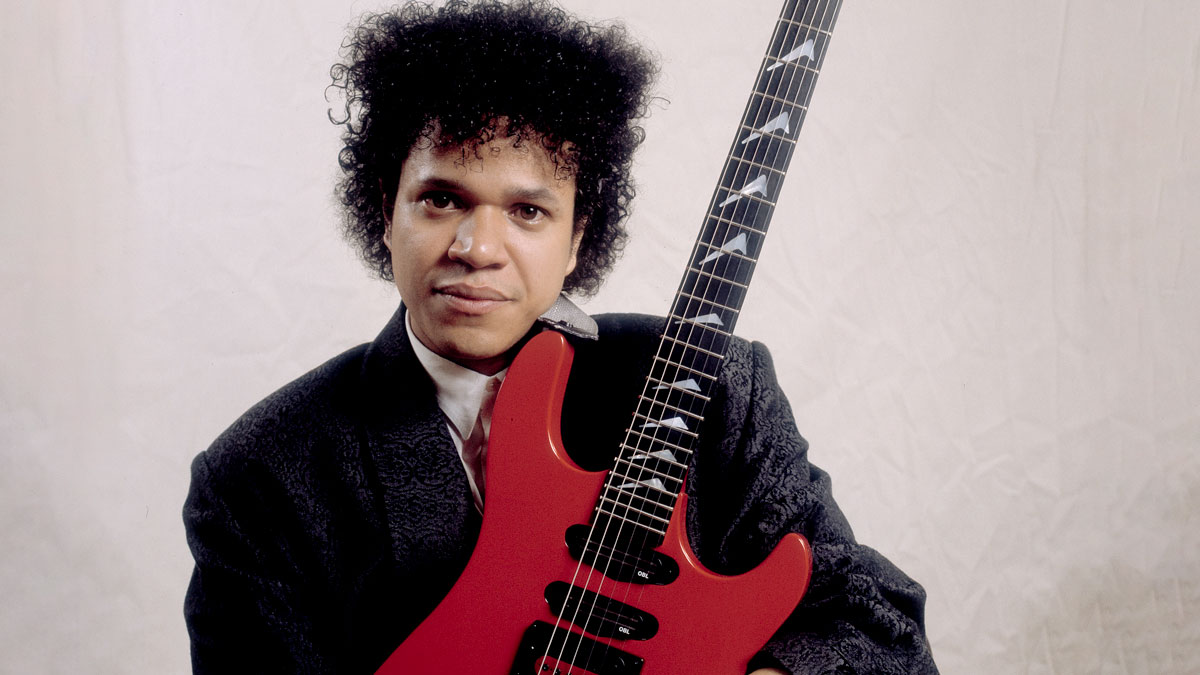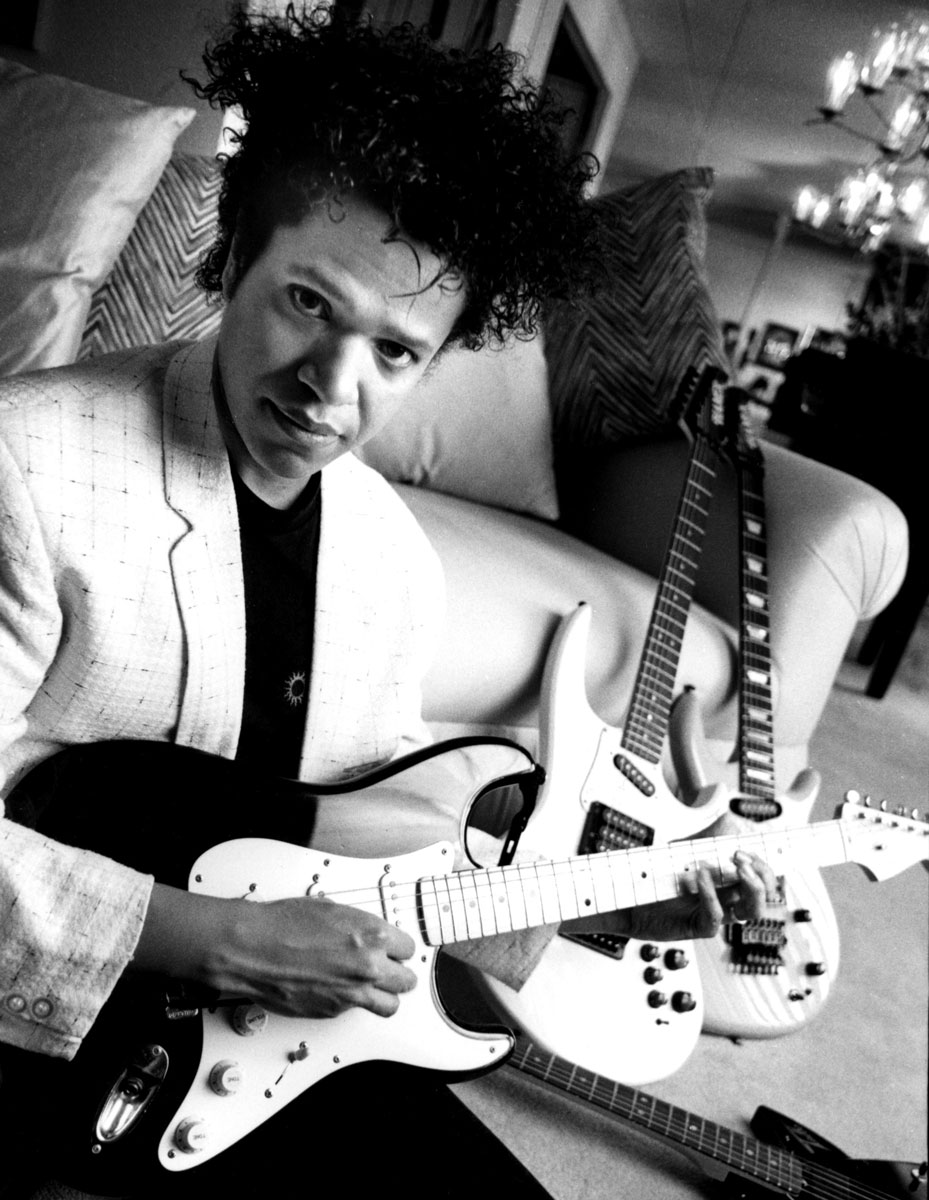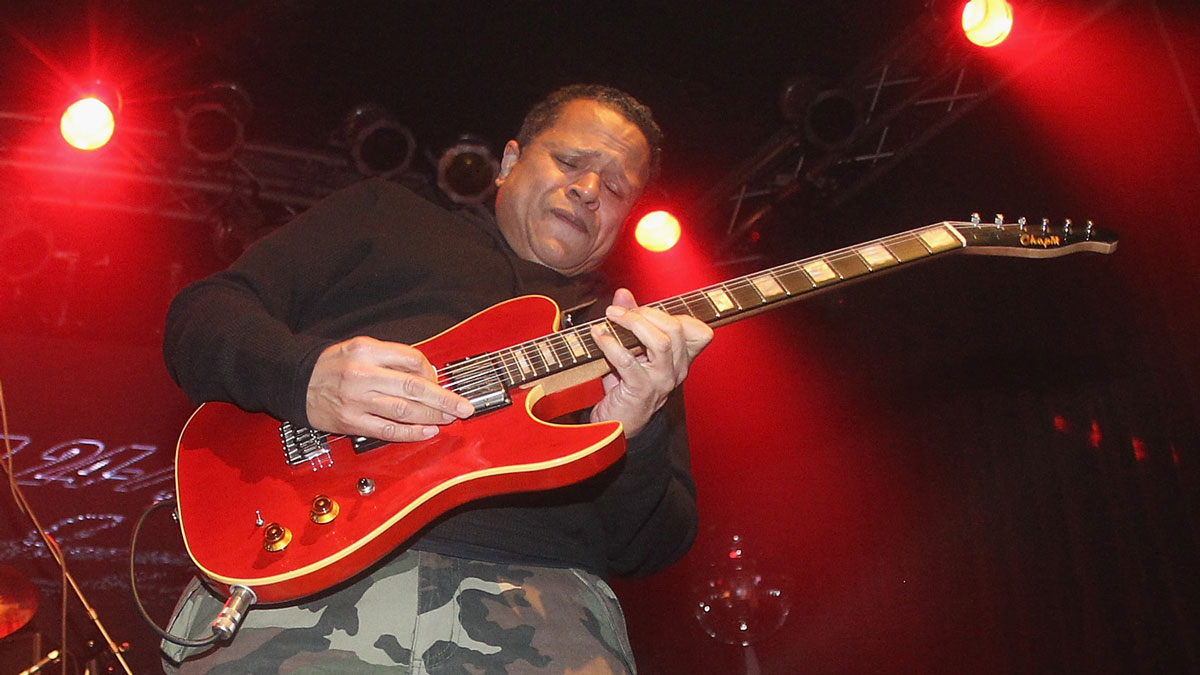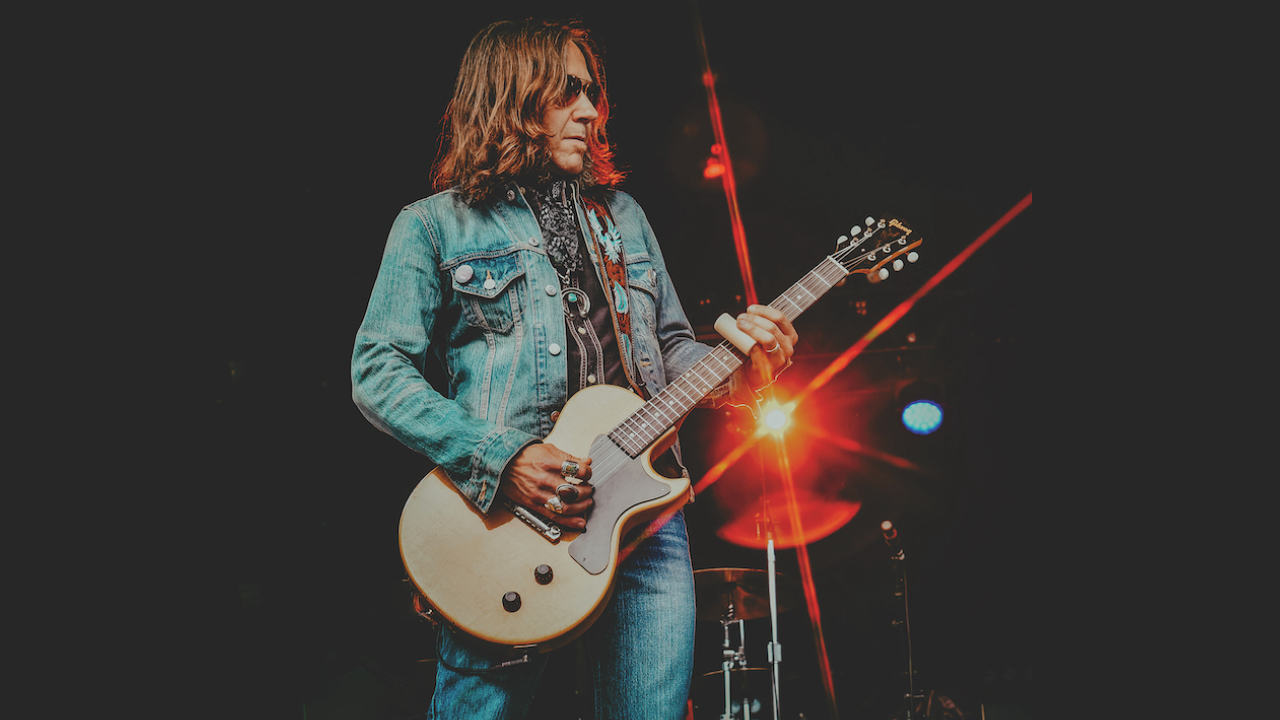Session guitar legend Eddie Martinez shares the studio secrets behind classic records from Run-D.M.C., Mick Jagger, Robert Palmer and David Lee Roth
Martinez looks back on soundtracking some of the biggest hits of the '80s – including working with Jeff Beck on Mick Jagger's She's the Boss, breaking down musical barriers with Run-D.M.C. and playing Live Aid – and explains why he thinks guitar is yet to be properly represented in hip-hop

When we look back on the '80s, we often think of a time when glamorous, MTV pop metal was the dominant force in guitar-driven music. It was an era when mad scientist shredders wielded technicolor slabs of mahogany, alder, and basswood in the name of glammed-out splendor.
And while these heroes of all things six-string defined the decade, another side of the proverbial coin remains. By the mid-'80s, rock and metal had saturated the charts, leaving some listeners looking for new and exciting ways to take in guitar theatrics.
To that end, players like Eddie Martinez – who starred across hit records by Robert Palmer, Mick Jagger, David Lee Roth, and most famously, Run-D.M.C. – made their mark.
When asked about his enduring influences across the genres during the '80s, Eddie Martinez quips: "Every session I've ever done, I had to give as much as I could. The truth is, in the session world, that is how you got called back.
"In most sessions back then, there weren't even charts. Sometimes if I was lucky, there would be a rough chart that was practically empty. Or you wrote out your own chart. It was my job to think of things, making hooks or finding hooks within hooks, or voicing chords in a particular way."
"Style comes from a philosophy of musical approach, and I think I've delivered that," Martinez continues. "So, regarding influence and meaning, I believe that comes from the fans because they've attached their meaning to what I have done. I'm so grateful for that. All I know is that I gave my all on those songs, and for people and musicians to attach that special meaning and significance is the proverbial icing on the cake. All I know is that I had so much fun creating it, and this kind of response all these years later is incredibly gratifying."
These days, Martinez is still active. Some 40 years after he shook up the world of guitar through his inspiring, genre-breaking leads and smoother-than-smooth rhythms, the NYC native has stopped championing the good word of multi-genre dominance. Still, even with his strides to ingratiate the guitar into the fabric of hip-hop, Martinez feels there's still work to be done.
All the latest guitar news, interviews, lessons, reviews, deals and more, direct to your inbox!
"I don't think the guitar is properly represented in hip-hop yet," Martinez insists. "I believe there's a lot more room for guitarists to make a statement in hip-hop. That said, it has to come from an authentic place, and it must be the artist's vision. I like what the Beastie Boys did with the sounds on Sabotage, but man, that was last century.
"I believe I made a statement with [Run-D.M.C.'s] Rock Box and King of Rock because it was organic, authentic, and the first. What inspires me today is when I hear a musician playing, and they have the freedom to their expression that is unbridled."
Busy at work on his latest music, Eddie Martinez set his guitar aside for a moment, dialing in with Guitar World to talk influences, touring with Blondie, being a hitmaker in the '80s, and the secret to good hip-hip guitar.
What first inspired you to pick up the guitar?
"The Beatles on the Ed Sullivan Show was the initial spark. So many of my friends and contemporaries feel the same way. The music was like a breath of fresh air, and it rang differently in my ears."
Who were your primary influences?
I saw Hendrix three times live, and he was incandescent. He literally reinvented the electric guitar and the infinite possibilities of the instrument. Hendrix was my North Star
"Then the next wave for me was Hendrix, Clapton, and Jeff Beck. Hearing Hendrix's Are You Experienced was a game changer. It sounded as if it was from another world with an enormous vibe. I can remember just being blown away and wondering how those sounds were made. I saw Hendrix three times live, and he was incandescent. He literally reinvented the electric guitar and the infinite possibilities of the instrument. Hendrix was my North Star."
What was it about Beck that stood out most for you?
"What can be said about Jeff Beck that hasn't already been said? Out of all the greats, I believe I've seen Jeff Beck live more than any other guitarist. I saw the first Jeff Beck Group with Ronnie Wood and Rod Stewart in the late '60s and have been a fan ever since. His evolution as a guitarist through the years was incredibly inspiring to me. I'm so lucky to have seen the arc of this incredible guitarist while we had him.
"His voice on the instrument was singular; he was one of the people doing things on guitar that still has us scratching our heads. I'm so lucky that I was able to play with him and to get to know him while recording Mick Jagger's first solo album, She's the Boss. He was very kind to me, and his passing was such a huge loss for us guitarists."

And how about Clapton?
"Eric Clapton has been such an incredible ambassador of the blues. In many ways, my introduction to the great American blues guitarists was through Clapton and Hendrix. How ironic that one of the true American art forms was discarded by us Americans only to be championed by the British, contributing to its resurgence.
"I still get goosebumps when I hear him switch to the bridge pickup on the solo for I Feel Free off the Fresh Cream album. The volume of what Clapton has done with his personal evolution of what the blues means to him as well as his body of work, makes him a complete artist. I had the privilege of recording with him in the late '80s, which was amazing."
How did touring with LaBelle in the '70s allow you to hone your chops?
"My takeaway from my experience with LaBelle was learning how to accompany great singers. That has been extraordinarily important to me as a musician. I got firsthand experience of what dynamics means from a vocalist's point of view. These are essential things for any musician or performance artist.
"Patti LaBelle, Nona Hendryx, and Sarah Dash had incredible voices. They had power and grace and projected their presence to the furthest seat in the theater. I was lucky to experience that for a year and a half. Musically, it was a high-energy gig, and you had to be on your toes. We did a lot of TV spots as well, which was an entirely different experience entirely."
How did you get hooked up with Blondie in the early '80s?
"A friend of mine called and told me Blondie was holding auditions and gave me a number to call. I then set up an audition. I had done tours with jazz fusion drummer Lenny White, as well as tours with Stanley Clarke and George Duke prior to this. Even though I considered myself more of a rocker than a fusion guy, I presumed that they thought I wouldn't fit in.
"So, I went to the audition with the intent of having fun regardless of the outcome. I went to the audition with a black Strat, dimed the Marshall, and played with intensity and attitude. Debbie [Harry] and the rest were super-cool to me. I left the audition feeling content that I had thrown caution to the wind and just played. By the time I took the D train uptown to my apartment in the Bronx, there was a message with a number for me to call. I called and was offered the gig. So, I presumed wrong – you never know how these things turn out."
What memories do you have of the "final" tour?
"I remember there being trepidation with Blondie touring because Chris [Stein] was unwell. But we went out there and toured the US. The tour was short-lived, and Chris's ailment was the reason the tour was canceled, and to my knowledge, Debbie didn't want to do it without Chris, which is entirely understandable. It was a great experience, and I dug banging out those crunchy punk-pop gems."
Not long after, you featured on Robert Palmer's Riptide. What was your approach, and how did your playing impact the sessions?
"My approach was to serve the songs and to collaborate musically with the producers and artists. Each of those records were all so different regarding approach. The most important thing for me was to elevate the song, which means, 'What can I contribute guitar-wise to make it better?'
"Most times, you have to come up with parts, musical hooks, motifs, et cetera. You can't be set in stone, and you need to listen to everyone playing and use your instincts to find parts. Although I had played on hit records before Riptide, I believe my work with Robert Palmer was the first time that I could entirely be me. Robert Palmer, Bernard Edwards, who produced, and Jason Corsaro, who engineered, were incredible to work with. I was able to incorporate huge rock sounds as well as lush pop and funk tones that were orchestrated to propel the songs.
"I also felt good that I had developed a signature sound with that album. I knew Addicted to Love was a hit after we recorded that track. You best affect the sessions by coming up with hooks that elevate the track and make it stronger than when you first walked into the studio.
"Through the years, there were so many sessions that the songs presented were mere skeletons that I had to flesh out with the parts and sounds I heard, and they became hits. People don't realize how much session musicians contribute to the magic of hit songs. It's a kind of rarefied air, and it's what we're paid to do."
Was it the same during the recording of Steve Winwood's Back in the High Life?
"Those recordings were kind of happening around the same time, I believe. It was an incredible and busy time. Busy is good. Steve Winwood was a joy to work with, as well as Russ Titelman, who produced the record. I had worked with Russ before, and it was always a blast. He loves that greasy and smelly funk part on a pop tune.
"On Higher Love and Freedom Overspill, it was mostly single-note funk lines that helped the track swing. I call that inside-the-track smelly stuff. It isn't frontal guitar for the most part, but they are parts that help make the song feel like a record, as is said in the business. I knew that Higher Love was going to be a huge hit, as well. I believe it won a Grammy for song of the year in 1986."
That leads us to David Lee Roth's Crazy from the Heat…
"Crazy from the Heat was a total blast. Dave was absolutely cool and professional. He expressed his gratitude for all of us being able to be there for the sessions. The tracks were cut live in Studio A at the Power Station. There were minimal overdubs on those tracks cut at the Power Station.
"On that project, as it was a live date, you get to feel how the song is evolving relative to what parts to play and what sounds to choose. When I saw a chart for California Girls, the first thing that crossed my mind was, 'Power chords would be cool on that pop masterpiece.' It worked. Ted Templeman was also great to work with; the sessions went very smoothly, and the rest is history."
As you were working on Mick Jagger's She's the Boss, did you feel pressure to play in the style of Keith Richards?
"I felt no pressure to play like Keith and was there to be myself. I could tell that when Mick showed us a song on guitar, he must've learned how to play from Keith. The way Mick swung on the guitar was reminiscent of Keith's pocket.
"I was allowed to be myself, and when working with Bill Laswell and Nile Rodgers, they want you to be creative and to be you. It was also great collaborating with Nile Rodgers, who lived just around the corner from me in the Bronx in our high school days. He's one of my oldest friends."
You mentioned earlier working alongside Jeff Beck during the She's the Boss sessions. What were your takeaways?
"I played with so many rhythm sections on the sessions for that album and recorded with Jeff Beck, which was special. It was kind of trippy in a good way playing with Jeff. His flow and trend of thought when recording was incredible, but I couldn't dwell on recording with such an iconic guitarist because I had a job to do: contribute and serve the music.
"They had been recording for a while before I got there with no keepers. On my first day, we cut She's the Boss, and that was a keeper. Sly [Dunbar] and Robbie [Shakespeare] said they were happy I was there and doing my rhythm parts. That was very nice of them. We recorded at Compass Point, Nassau, Bahamas, and the Power Station in NY."
What memories do you have of performing with Mick at Live Aid?
At first, the guitar wasn't a primary instrument in hip-hop… Luckily, Rock Box changed that with a new flavor that made the guitarist crank up on some beats
"Without a doubt, that was the fastest, most amazing 20 minutes of my life. I have a great memory of the night before Live Aid in an empty JFK stadium with only Mick, Tina [Turner], Daryl Hall, John Oates, David Ruffin, Eddie Kendricks, G.E. Smith, myself, and the entire band. We went through the songs with Mick and Tina, and the energy that we produced in an empty stadium was unforgettable.
"It was surpassed the following night in front of 85,000 people. The energy we created on that stage was matched by the audience. I've never ever felt that kind of reciprocal energy before or since. It was next-level. I still remember being in the motorcade heading to the stadium the night of the gig, eating red lights like it was going out of style."
How did you first become involved with Run-D.M.C.?
"Larry Smith, who produced Rock Box and King of Rock, was a good friend and bassist. We played in a lot of bands in our younger years. There was a point where he jumped into the hip-hop scene, and I started to get into the touring and eventual session scene. Larry fully immersed himself in what was happening in the hip-hop world. I remember the first hip-hop sessions I did was for Kurtis Blow. But the first big guitar was on Rock Box."
How prevalent was guitar in hip-hop to that point?
"Mind you, I had been playing with all sorts of artists from LaBelle, Robert Palmer, Winwood, and Jagger to Yoko Ono and wasn't confined to one genre. But for guitarists that were in the hip-hop scene, I would imagine it was the beginning of something eventually incredible. But at first, the guitar wasn't a primary instrument in hip-hop. It was beats, bottom, and DJs doing their thing, spinning, and scratching. Luckily, Rock Box changed that with a new flavor that made the guitarist crank up on some beats."
Can you recount the recording of Rock Box?
"When I first heard Rock Box, it was sparse. It was a DMX drum machine, a bass guitar, and the tinkling synth motif, Run-D.M.C. rap, and Jam Master J's vibe. Larry Smith asked me to put big rock guitar on it, and I went to work. I reinforced the bass line with massive-sounding guitars, built on some of my riffs, harmonized them, and then soloed over the whole track. It was a guitar orchestra.
"It was great to have that canvas to put my vibe on, and it was a total blast. This is a clear example of elevating a track and using my style of guitar in propelling that piece of music. You don't press a preset button and get that performance. It's what a lot of people don't realize and that a lot of other great studio guitarists never get credit for.
How often have you heard studio players say, 'Well, I got to the session, and the sheet music was blank but had one chord symbol, so I built on that.' That's the way it was in many cases
"How often have you heard studio players say, 'Well, I got to the session, and the sheet music was blank but had one chord symbol, so I built on that.' That's the way it was in many cases. Nevertheless, I'm grateful that I contributed in a big way and helped it be a worldwide iconic hit.
"I've said this before: I felt great when I left the studio that night, but I didn't know it would have such an enormous historical impact. You never know sometimes… it became the precursor for a whole new thing."
What gear did you use during the recording of the track?
"I recorded Rock Box with my Hamer Prototype, my hitmaker back then; it was used on Robert Palmer's Addicted to Love and David Lee Roth's California Girls. I also used a Music Man 2x12 combo that was a studio amp and a Boss OD-1. I wanted big authentic, crunchy guitars with all that analog fatness and no buzzy-sounding stuff.
"It's been well accounted for that the big guitars took Run DMC by surprise, and they weren't happy at first. But it all worked out in the end because that record blew up and changed everything. It became an iconoclastic track."
How did you develop the distorted guitar sound you deployed across King of Rock?
"On King of Rock, I used another studio amp. I believe it was a Sound City head and 4x12 cabinet. The sound was big and had a bit more edge to it that was appropriate for the irreverence of the track. The whole track and video were just a killer metaphor with trashing convention. Doing the video with Larry "Bud" Melman [aka Calvert DeForest] was dope.
"It was something where I had a sonic idea of where the guitar should be perspective-wise compared to everything else. The big guitar was so successful with Rock Box that I wanted to do something in that tradition but slightly different. There was plenty of space to be huge, but it's something that I ultimately felt instinctively. I think King of Rock is slightly edgier than Rock Box and pairs with the comic irreverence of the video."
I'd be remiss if I didn't mention Robert Palmer's Simply Irresistible. What gear and approach did you deploy?
"Oh, that was a fun track, and I heard all sorts of things on that one! Robert was such a brilliant composer. He knew how to structure a song and leave enough space for guitars. Hearing his music was inspiring, and he loved me pushing the envelope, which I did on the solo that he called 'Large Marge' from the Pee-wee Herman movie [Pee-wee's Big Adventure].
"I was able to incorporate some things that were intervallic, chromatic, quasi-bebop, and whole tone in my solo. I came up with big guitar hooks on that track as well. I used Marshall JCM800s modified by Harry Kolbe in NY. I then used a KOLBE box converting speaker level to line level and had a Yamaha power amp to drive, I think, six 4x12s.
"After the tracks were cut, I also put a guitar D.I. with engineer ET Thorngren with a Pro Co Rat to give a sonic point to that massive 4x12 barrage. On that track, I used a Jackson Soloist that Grover Jackson personally gave me, as well as a Hamer 12-string that's tucked in the mix."
Which sessions mean the most to you?
"I believe the three Robert Palmer albums, as well as Jagger’s first solo record, have a lot of significance. Plus, recording with Ryuichi Sakamoto, my band Distance, and my solo album No Lies.
"I released a solo album a few years ago titled Akosua, and it's on iTunes. I'm finishing up on a new EP titled Elephant, which contains tunes that I recorded years ago with the late engineer and producer Jason Corsaro that I feel still rocks. Then another new LP which I'll start recording later this year."
Do you prefer vintage guitars or new ones?
"I have vintage Fenders and CS and Masterbuilt Fenders as well as vintage Gibsons and Murphy Lab Gibsons. I also have John Suhr guitars that are excellent. It's all about application for me and what will do the job. I personally like to mix it up with Saul Koll guitars, Ronin, Nacho, and Clive Brown guitars, as well.
What amps and other gear are you using? Are you okay with Kempers, or do you prefer tube amps?
"I use Bludotone, Suhr, Benson, Fender, and Boogie amps. I haven't used a Kemper, but I'm having a lot of fun with the Fractal FM9. There's a use and purpose for all the modern technology, but I lean towards tube amps."
Are you a pedal addict? If so, which do you like?
"Yes, I'm a pedal addict. I currently like Crazy Tube Circuits Starlight and Unobtainium pedals and the Kasleder Toxic Twins pedal, Eventide H9, Benson pedals, as well as the Suhr Discovery analog delay, which sounds beautiful."

Do current trends alter your present-day technique at all?
"I'm amazed at what some of the younger players are doing on the instrument technique-wise, and still blown away by what legendary cats like John McLaughlin are still doing. For me, it's about expanding my vocabulary on the instrument. It could be the smallest thing or perhaps a riff or a phrase that I've never played before. Those little things blow my mind, as well as finding new ways to make a statement.
"I believe listening to other styles of music inspires me very much, and I particularly love film music. I love listening to Thomas Newman, Hans Zimmer, John Williams, Alan Silvestri, Lyle Workman – who happens to be a monster guitarist – and Alexandre Desplat, to name a few. It makes me think and phrase differently when I pick up a guitar after listening to a film score."
What's the secret to good hip-hop guitar playing?
"I don't know if there's a secret or not, but you have to tap into the spirit and vibe of the hip-hop track. You need to be funky when needed and when to be rude with powerful big crunchy guitars or any type of guitar regardless of style. But the most important thing is being open to different styles and being authentic in your approach."
Andrew Daly is an iced-coffee-addicted, oddball Telecaster-playing, alfredo pasta-loving journalist from Long Island, NY, who, in addition to being a contributing writer for Guitar World, scribes for Bass Player, Guitar Player, Guitarist, and MusicRadar. Andrew has interviewed favorites like Ace Frehley, Johnny Marr, Vito Bratta, Bruce Kulick, Joe Perry, Brad Whitford, Tom Morello, Rich Robinson, and Paul Stanley, while his all-time favorite (rhythm player), Keith Richards, continues to elude him.

